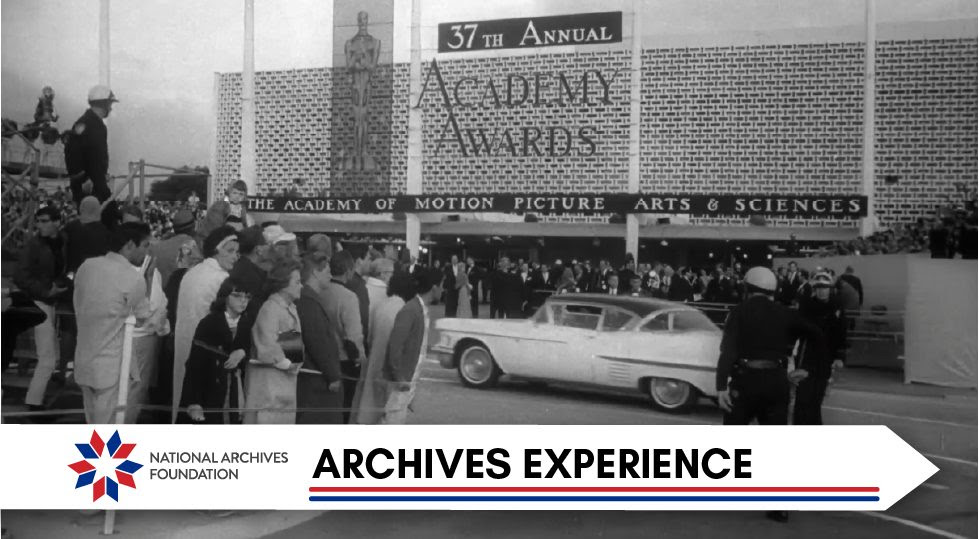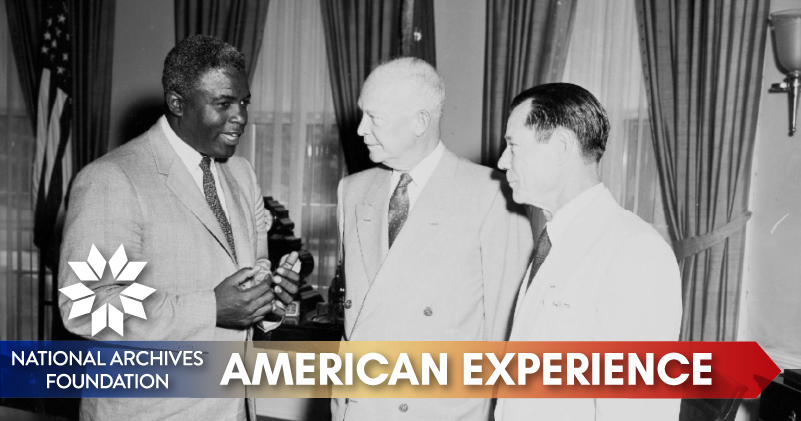Red Carpet Records

Lights! Camera! Action! It’s Oscar time in Hollywood, that night when all the stars dress to the nines, walk the red carpet, smile for the camera, and the lucky ones are awarded the famous golden statuettes for their contributions to American film from the Academy of Motion Picture Arts and Sciences. Those of us at home watch the televised program for the fashion hits (and flops), the big production numbers, the surprise winners (and snubs) and whether the host delivers an entertaining show.
There’s always been a close relationship between art, history and the US government, so it’s not a surprise that several Oscar winners can be found in federal records. They’re still available to us thanks to the National Archives’ Moving Image and Sound Lab, which has performed conservation and digitization on thousands of miles of film holdings.
If a picture is worth a thousand words, what’s an entire movie worth? Today, we’re going to let the Archives’ film holdings do the talking…
In this issue
Capra quit his directing job within four days of the bombing of Pearl Harbor and was commissioned a major in the U.S. Army…
Ford always proudly included in his Oscar count the two he won for documentaries he filmed during the war…
History Snack
Silver Screen Soldiers
Spurred by the bombing of Pearl Harbor in 1941, directors John Ford and Frank Capra both offered their film-making expertise to the U.S. military. Frank Russell Capra, born Francesco Rosario Capra in 1897 near Palermo, Italy, came to the United States at the age of five with his parents and four siblings on the steamship Germania in 1903. From there, the family crossed the country to Los Angeles via train, settling in the East Los Angeles neighborhood of Lincoln Heights, where Francesco attended school during the day and sold newspapers in downtown L.A. to help his parents make ends meet. After he graduated from high school, he worked his way through the California Institute of Technology in Pasadena, where he studied chemical engineering and completed Reserve Officers’ Training Corps courses. He graduated in 1918 and was commissioned into the U.S. Army as a second lieutenant, but he caught the Spanish flu and was sent home to live with his mother, since his father had died that same year. In 1920, he became a naturalized U.S. citizen, changing his name to Frank Russell Capra.
Capra left home and knocked around quite a bit, taking odd jobs and rambling around the Western He finally caught a break when he got some work for San Francisco film studios that eventually led to producer Harry Cohn hiring him to work for him in Los Angeles. He also worked as a writer for comedian Harry Langdon before returning to Cohen’s studios Columbia Pictures in 1928.
The advent of sound in motion pictures in “The Jazz Singer” in 1927 gave Capra his big break. His engineering background made him comfortable with the technology, which put him ahead of many of his peers in the industry. Starting with “The Younger Generation” in 1929, Capra piled up a string of hit films that included “Lady for a Day” (1933); “It Happened One Night” (1934), which won all five top Oscars; “Broadway Bill” (1934); “Mr. Deeds Goes to Town” (1936), for which he won his second Best Director Oscar; “You Can’t Take It with You” (1938), for which he won his third Best Director Oscar; and “Mr. Smith Goes to Washington” (1939).
Capra quit his directing job within four days of the bombing of Pearl Harbor and was commissioned a major in the U.S. Army. He worked directly for Chief of Staff George C. Marshall, who later created the Marshall Plan for rebuilding Europe after the war. Marshall charged Capra with creating “a series of documented, factual-information films—the first in our history—that will explain to our boys in the Army why we are fighting, and the principles for which we are fighting. . .” The films that Capra produced, collectively titled “Why We Fight,” included seven episodes: “Prelude to War” (1942), “The Nazis Strike” (1942), “Divide and Conquer” (1943), “The Battle of Britain” (1943), “The Battle of Russia” (1943), “The Battle of China” (1944), and “War Comes to America” (1945). The series was praised to the skies, and 20th Century Fox released the first episode, “Prelude to War,” nationally. It won the 1942 Academy Award for Best Documentary Feature.
In anticipation of victory in Europe in 1945, Capra teamed up with writer Theodor Geisel (later known by his pen name, Dr. Seuss) to produce a documentary titled “Your Job in Germany.” Running just short of 13 minutes, the film is a direct and no-nonsense explanation of the U.S. military’s policy of nonfraternization aimed at the American soldiers who would be occupying Germany after the Allied victory. No one who watched the film could mistake its message. “The Nazi party may be gone, but Nazi thinking, Nazi training and Nazi trickery remains,” the narrator announced. “The German lust for conquest is not dead. . . . You will not argue with them. You will not be friendly. . . . There will be no fraternization with any of the German people.”
Jack Warner, who was the head of Warner Brothers, bought the rights to “Your Job in Germany” and released it on December 29, 1945, under the title “Hitler Lives?” as a short documentary. The film won the 1946 Academy Award (Oscar) for Documentary Short Subject.
Your Job in Germany
(14 minutes 24 seconds)
National Archives Identifier: 4529712
Pacific Theater
Born in Maine in 1894 to Irish immigrant parents, John Ford graduated from high school and then followed his brother Francis to Hollywood, where Francis had established himself as an actor for Universal Studios. The younger Ford worked all kinds of jobs for Universal, including prop man, stuntman, actor and assistant director, before he got his first chance to direct in 1917. His 1924 silent film “The Iron Horse,” about the building of the transcontinental railroad, was the break-out film of his career and the first of more than 30 Westerns he went on to make in more than five decades in the industry. Ford was also largely responsible for discovering and promoting the actor John Wayne, who starred in many of Ford’s most famous films.
John Ford won six Oscars, including four for Best Director. He had joined the U.S. Naval Reserves in the 1930s, so when World War II began, Ford went on active duty and was commissioned an officer in the Navy. He was put in charge of a documentary film unit. He always proudly included in his Oscar count the two he won for documentaries he filmed during the war: “The Battle of Midway,” which he made for the War Activities Committee, which featured actors Donald Crisp and Henry Fonda, and which won the Academy Award for Best Documentary Feature; and “December 7th,” a short film he co-directed with Lt. Gregg Toland, USNR, a famed cinematographer both before and after the war, for the U.S. Navy, which won the Academy Award for Documentary Short Subject.
Ford roundly and constantly criticized John Wayne for not serving in the U.S. military during the war. Wayne did register with the Selective Service in 1941, but he was 34 years old and he was married with four kids at the time, so the draft board wasn’t eager to send him overseas at that point. By the time he was eligible for enlistment again in 1943, Republic Studios, which held his contract, intervened to keep him at home because he was their sole A-list actor still in the States. None of this impressed John Ford, who needled Wayne about his lack of military service for years. Pilar Wayne, John Wayne’s last wife and widow, stated that her husband felt guilty for the rest of his life for not serving during the war.
The Battle of Midway
(18 minutes 38 seconds)
National Archives Identifier: 12870
The Art of Persuasion
From 1951 through 1964, the United States Army Signal Corps Army Pictorial Service produced a television series titled “The Big Picture,” that drew on the talents of many Oscar-winning actors such as Helen Hayes, who had won the Academy Award for Best Actress in a Leading Role for “The Sin of Madelon Claudet” in 1932, and Henry Fonda, who went on to win the Oscar for Best Actor in a Leading Role for “On Golden Pond” in 1981. Throughout World War II, the U.S. military had been steadily recording events on film and carefully storing the material. The first 13 half-hour episodes of “The Big Picture” were about the Korean War, but the series was well enough received that the Army decided to continue to produce it and to expand the subjects to include military weaponry, military history and cooperation with allied forces.
Well-known actors such as Ronald Reagan and Audie Murphy narrated individual film segments, which were then linked with narration by host Army Master Sergeant Stuart Queen.
In Episode 512, “The Challenge of Ideas,” host Edward R. Murrow describes the conflict between Communism and the American way of life as primarily a conflict of different values. The camera then cuts to John Wayne, sitting in a director’s chair on a movie set, calmly delineating how the American people differ from those living under a Communist regime.
As his wife Pilar observed after his passing, John Wayne became a “super patriot” after World War II because he felt guilty for not having served in the war. By the time this episode of “The Big Picture” was filmed in 1960, Wayne had also, of course, acted in dozens of war movies, many of them about World War II, so in the public’s mind, he was practically, if not in reality, a war hero, which made him a perfect spokesman for American values.
Challenge of Ideas
(10 minutes 13 seconds)
National Archives Identifier: 2569750
Ronald Reagan interview on John Wayne
(11 minutes 34 seconds)
National Archives Identifier: 117700573

View this profile on InstagramNational Archives Foundation (@archivesfdn) • Instagram photos and videos




